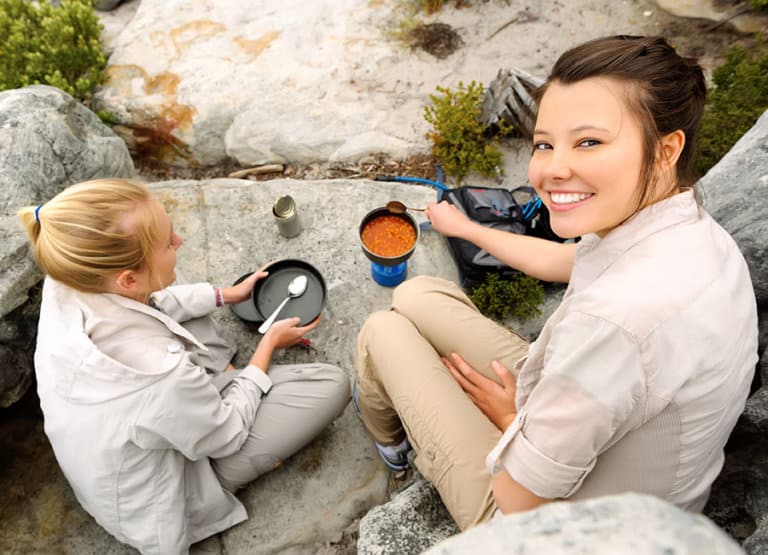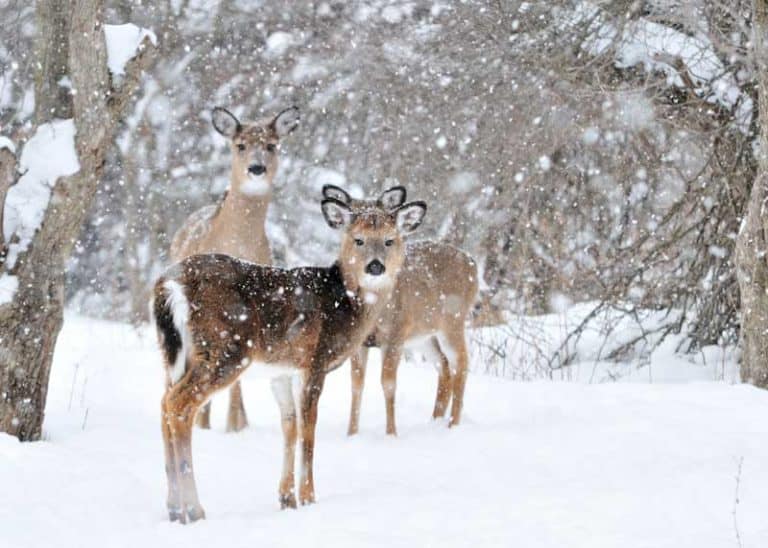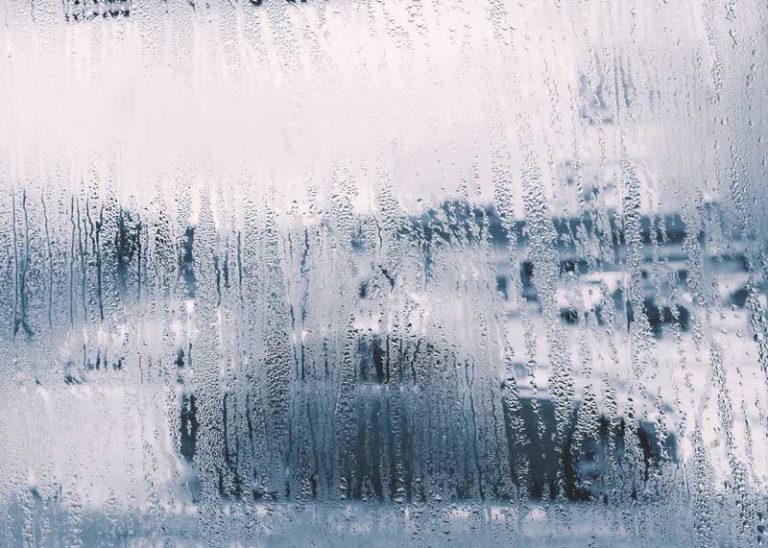29 Winter Camping Tips: Freezing But Safe, Warm, Cozy
Camping in the winter is a unique experience compared to the rest of the year. These winter camping tips will help you have a safe, warm, and successful trip.

Check out our full Guide to Winter Camping
29 Winter Camping Tips for Safe Adventures
1. Weather
Checking the weather forecast both before you set out on your trip and during is a must.
Staying warm and dry being the highest priority there is. It also means that if a bad storm or worse, a blizzard blows in, it can greatly affect or even stop emergency help getting to you, sometimes for days.
2. Take a Day pack
If you are planning on exploring around your campsite and doing some day hikes then take a lightweight day pack to carry essentials like water, snacks, a map, compass, first aid kit, thermal blanket etc.
It is especially important to take provisions during winter in case you get turned around, lost or injured, the winter nights are not as forgiving as those during summer and that lightweight emergency blanket could save your life.
3. Plan your camp and camp your plan
We’ve all seen and heard of those movies about adventurers and adrenaline junkies getting caught mountain climbing or having an accident while hiking in the remote wilderness and it’s a miracle they survived.
To help prevent that from happening to you it’s a good idea to let someone know the plan of your trip.
Tell them the area you will be hiking through and camping in. That way if you’re expected to return on Sunday and don’t show up they can alert the authorities.
Sticking to the plan means you aren’t the one in the dangerous situation of nearly starving to death in an underground cave or ravine you may have slipped into before rescuers found you. Locals will know what the hazards are in, and around your camping area.
4. Invest in good winter clothes
Sealed tight to hold in warmth is what you want during a winter camping trip.
It is worth spending that little bit extra to ensure you are going to be comfortable, especially at night when the temperature starts to drop, so it’s worth that extra $20 or $50 for good boots, thermals or clothes designed to handle winter temperatures.
5. GPS and Navigation
You can pick up a great little gadget with GPS, emergency signaling ability, and built-in navigation from just about any electronics store.
It’s a good idea to always take one with you when camping no matter what time of year, but especially during winter adding peace of mind to your trip as well.
Here’s how to use a compass without a map.
6. Keep Drips out
Your tent, tent fly, boots, and even your pack should be waterproofed to prevent leakage from snow melting or heavy dews and fog in the morning.
Once you’re waterproofed, you should consider insulating your tent.
7. Don’t Drink Before Bed
Reduce your chances of needing to battle the cold during the much-dreaded midnight wee walk by not drinking anything for a couple of hours before you turn in for the night.
Not only will it increase your chances of making it through the night, but you also won’t spend half of it trying to get warm again.
8. Learn Basic First Aid
This is for every person spending time in the great outdoors. Even if you only go camping occasionally, being prepared for and knowing how to deal with an injury, burn or sting will set your mind at ease and build your confidence knowing you can handle anything that arises.
This is particularly important if you are planning on camping in a remote location and emergency services may take longer to reach you.
9. Snug as a Bug in a Rug
Keep your hands and feet warm with small hand heat packs. They can last 10+ hours and the good news is that they’ll keep getting warmer once they’re in your pocket or sleeping bag – keeping your feet warm for a great night’s sleep.
Many of these warmers will last up to 18 hours.
10. Candles are more than romantic
If you have a small candle lantern that won’t burn down your tent, a burning candle will not only provide a little extra heat, it will also help prevent condensation inside your tent.
11. Store food properly
Winter is a time of scarcity in the wilderness, so to prevent squirrels and raccoons from rummaging through and stealing all your food on midnight raids to your campsite, stow your food properly and keep it up off the ground.
Plus, it helps keep everyone from freaking out in the middle of the night when they hear an animal outside. Because sound carries so beautifully in winter, a small squirrel can sound about the size of a bear!
Here’s how to keep bears away while camping
12. Emergency Everything
A watertight container with fresh batteries for all of your electronics like your sat phone, GPS, radio, and lamps can not only provide fun with music and dancing but also save your life with the latest weather update or prevent you stumbling around in the dark until your night vision kicks in.
13. Two Mats Are Better Than One
A thick sleeping pad, or preferably two if you can, will help you retain that precious warmth. We lose the most body heat through the bottom of the tent so this is the one thing you may want to double up on.
Or you might consider an insulated, all-season sleep pad.
14. Aluminum Foil is your friend
Not only can you wrap your food and cook in the coals of your fire, but it also doubles as a highly reflective beacon to signal rescuers and is strong and completely waterproof so when folded over a few times can be used to patch gear temporarily.
It won’t hold up under torrential rain, but it can stop dew drops from seeping in and dripping on your face.
15. Extra rope
As everything is a little soggier during winter, rope can be used for making clotheslines, a tie off between trees to drape a small tarp over for keep firewood dry, and for hanging things from trees that you do not want animals getting into.
In other words, it’s one of the handiest bits of kit you can take so make sure and take extra because it can be used for everything.
16. Take a pee bottle
Yes, it sounds gross but when we are cold (for some strange reason) we tend to want to pee more frequently, right!? A pee bottle will mean you don’t have to venture out into the cold and return half frozen, then take hours warming up again.
And for the ladies, you might consider the She Wee.
17. If camping on snow, pack it down first
Say you found the perfect spot but it is covered in snow, it’s okay, you can camp there but be sure to pack the snow down hard first otherwise you may step straight through the floor of your tent into a hidden hole – ripping your floor in the process.
18. Pick your site carefully
When you first arrive and the sun is shining brightly, you want to enjoy it but take a moment to think of how your campsite will be during the night.
Valleys often fill with mist and fog which may take hours to clear in the morning, this means you stay colder for longer.
Just take a moment to think about where you pitch your tent so you can enjoy the sun on your face with your morning coffee as everything dries out from the night before.

19. Heat your Boots
If your boots have a removable lining then put the liner in your sleeping bag when you go to sleep. This means a merry warm start to your next morning.
If your boots do not have removable linings, then at least bring your boots inside and put them in a bag at the bottom of your sleeping bag to keep them warm and keep you from getting hypothermia when you step into them in the morning.
20. Turn your water upside down
When you camp somewhere that gets cold enough to freeze water you will notice that water freezes from the top down.
So, at night turn your water container upside down to store overnight so when you flip it right side up in the morning you have access to water because the spout hasn’t frozen over and you have to wait hours for it to thaw before you can have that all important cup of coffee.
Of course, if it is really cold, your bottle might freeze solid. If that’s the case, you’ll probably have access to snow (or ice) that you can scoop and melt on the campfire.
21. Put up a wind block
This will help stop those icy winds from penetrating your tent offering everyone inside more protection from the elements, and retaining whatever heat that has built up inside.
22. Vaseline Your Extremities
Alright, we admit this one is for if you are camping in the heart of winter somewhere really, really cold.
But if you do find yourself in this situation, then applying Vaseline or something similar will stop windburn and you’ll be less prone to frostbite. Better to be greasy than missing fingers. It’s an Inuit trick they’ve been doing for ages and they should know.
23. Lithium Batteries are Best
Better to handle the temperature, lithium batteries will last up to three times longer and are lighter than other batteries so are the best choice for the electronics you are taking with you (and as the backup batteries).
24. Flints and Firestarters
Matches, even waterproof matches can be difficult or downright impossible to use once they get damp. The same goes for lighters and seeing as how winter has that wonderful way of making everything damp for days, well the easiest solution is to learn how to use a flint.
If you don’t like using them, then at least take one as a backup so you can get toasty warm by the fire if your lighter runs out of gas. These really are must have survival gear.
25. Stroll before Bedtime
Taking a little 5-minute walk around the campsite will warm you up before bedtime which will help you warm up your sleeping bag a little quicker. A handy little trick to get snuggly in no time.
26. Backpack savior
If your backpack just happens to be empty and laying around then pulling it up over your feet and up to your knees will trap heat around your feet and provide that extra layer of warmth.
It may take a moment to get used to but toasty warm feet are the best way to ensure a great night’s sleep, even if your friends giggle at you. You’ll have the last laugh in the morning.
27. Know the Area You Are Camping In
Before you leave, do some research and get to know what’s around your campsite. The terrain, the topography, rivers etc. especially if you intend to do some hiking and exploring during the time you are out there.
Knowing nearby trails can get you out of trouble if you get turned around in a snow-covered landscape.
28. How to Heat a Tent in Winter
Aside from body heat, you basically have two options for heating your tent in the winter: combustion and electric.
- Electric heaters are great for backyard camping or serviced campsites. They don’t run out of fuel and don’t produce any dangerous gases.
- Combustion heaters are going to be your best bet for most winter camping trips.
Here’s our Safe Camping Guide to Tent Heaters
29. Warmest Blanket for Winter Camping
This can be a pretty subjective choice. But when it comes to camping in winter, you need a warm, water-resistant, lightweight choice.
The SnugPak survival blanket is windproof, water resistant, rated to 36 Fahrenheit. Check current price of the SnugPak Survival Blanket
While this won’t be enough for an actual winters night of camping, partnered with a proper sleeping bag, you’ll be good and toasty. Because of the windproof layer, it is even warmer than thicker blankets without that feature.

Your Turn
What are you planning for camping this winter? Have a question – or maybe a tip to share? Join me in the comments!








